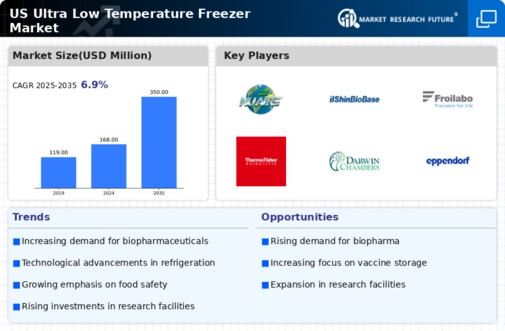Technological Innovations
Technological innovations play a pivotal role in shaping the ultra low-temperature-freezer market. Manufacturers are increasingly focusing on developing energy-efficient models that not only reduce operational costs but also minimize environmental impact. The introduction of smart technology, such as remote monitoring and alarm systems, enhances the usability and reliability of ultra low-temperature freezers. These advancements are expected to drive market growth, as users seek more efficient and user-friendly solutions. The market is anticipated to witness a shift towards more sophisticated models that incorporate advanced features, which could potentially increase the average selling price of ultra low-temperature freezers. As technology continues to evolve, the ultra low-temperature-freezer market is likely to adapt, ensuring that it meets the changing needs of its users.
Expansion of Clinical Trials
The expansion of clinical trials is a notable driver for the ultra low-temperature-freezer market. As pharmaceutical companies and research institutions conduct more clinical trials to test new drugs and therapies, the need for proper sample storage becomes increasingly important. Ultra low-temperature freezers are vital for preserving biological samples, ensuring their viability throughout the trial process. The market is projected to grow as the number of clinical trials increases, with estimates suggesting a growth rate of approximately 10% annually. This trend indicates a strong correlation between the rise in clinical trials and the demand for ultra low-temperature freezers, as researchers prioritize the integrity of their samples. Consequently, the ultra low-temperature-freezer market is likely to benefit from this ongoing expansion in clinical research.
Increased Research Activities
The ultra low-temperature-freezer market is experiencing growth due to heightened research activities in various sectors, particularly in pharmaceuticals and biotechnology. Research institutions and laboratories are increasingly investing in advanced freezing technologies to preserve biological samples, vaccines, and sensitive materials. The market is projected to reach approximately $500 million by 2026, driven by the need for reliable storage solutions. As research initiatives expand, the demand for ultra low-temperature freezers is likely to rise, indicating a robust growth trajectory for the industry. Furthermore, the emphasis on innovative research methodologies necessitates the use of ultra low-temperature freezers, which are essential for maintaining sample integrity and ensuring accurate results. This trend underscores the critical role of ultra low-temperature freezers in supporting scientific advancements and the overall growth of the ultra low-temperature-freezer market.
Growing Biopharmaceutical Sector
The biopharmaceutical sector is a significant driver for the ultra low-temperature-freezer market, as the industry continues to expand rapidly. With the increasing number of biopharmaceutical products entering the market, there is a heightened need for effective storage solutions to maintain the stability and efficacy of these products. The ultra low-temperature-freezer market is projected to grow at a CAGR of around 8% over the next five years, reflecting the increasing reliance on these freezers for the storage of biologics, including monoclonal antibodies and gene therapies. As biopharmaceutical companies prioritize quality control and regulatory compliance, the demand for ultra low-temperature freezers is expected to surge, further solidifying their importance in the industry. This growth in the biopharmaceutical sector is likely to have a lasting impact on the ultra low-temperature-freezer market.
Rising Demand for Vaccine Storage
The ultra low-temperature-freezer market is significantly influenced by the rising demand for vaccine storage solutions. As vaccination programs expand, particularly in the context of public health initiatives, the need for reliable storage systems becomes paramount. Ultra low-temperature freezers are essential for preserving the integrity of vaccines, which often require storage at temperatures as low as -80°C. The market is expected to see a surge in demand, with projections indicating a potential increase of 15% in sales over the next few years. This trend highlights the critical role of ultra low-temperature freezers in ensuring the safe storage of vaccines, thereby supporting public health efforts. The increasing focus on vaccine distribution and storage logistics is likely to further bolster the ultra low-temperature-freezer market.
























Leave a Comment